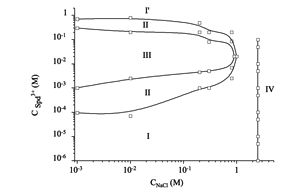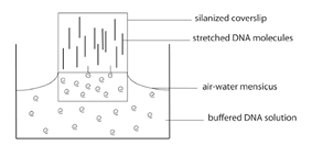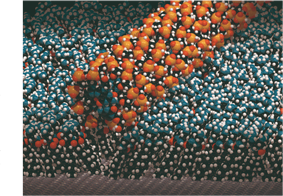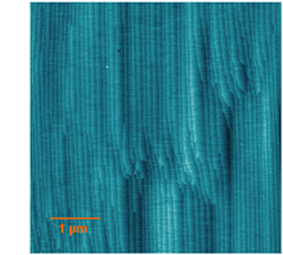DNA at interfaces
Aggregation and Adsorption at the Air-Water Interface of Bacteriophage ΦX174 Single-Stranded DNA

We study the phase behavior of phage ΦX174 single-stranded DNA in very dilute solutions in the presence of monovalent and multivalent salts, in both water (H2O) and heavy water (D2O). DNA solubility depends on the nature of the salts, their concentrations, and the nature of the solvent. The appearance of attractive interactions between the monomers of the DNA chains in the bulk of the solution is correlated with an adsorption of the chains at the air-water interface. We characterize this correlation in two types of aggregation processes: the condensation of DNA induced by the trivalent cation spermidine and its salting out in the presence of high concentrations (molar and above) of monovalent (sodium) cations, both in water and in heavy water. The overall solubility of single-stranded DNA is decreased in D2O compared to H2O, pointing to a role of DNA hydration in addition to electrostatic factors in the observed phase separations. DNA adsorption involves attractive van der Waals forces, and these forces are also operating in the bulk aggregation process. (in coll. with Jean-Louis Sikorav and Arach Goldar).
A simple and optimized method of producing silanized surfaces for FISH and replication mapping on combed DNA fibers

Molecular combing of DNA is an extremely powerful DNA fiber-stretching technique that is often used in DNA replication and ge- nome stability studies. Optimal DNA combing results mainly depend on the quality of the silanized surfaces onto which fibers are stretched. Here we describe an improved method of liquid-phase silanization using trimethoxy-octenylsilane/n-heptane as novel silane/solvent combination. Our simple method produces homogenously modified coverslips in a reproducible manner, but does not require any sophisticated or expensive equipment in comparison to other known silanization protocols. However, DNA fibers were combed onto these coverslips with very good high-density alignment and stayed irreversibly bound onto the surfaces after various de- naturing treatments, as required for different immunofluorescent detection of DNA with incorporated modified nucleotides or FISH. (in coll. with Hélène Labit, Arach Goldar, Guillaume Guilbaud, Olivier Hyrien, and Kathrin Marheineke).
DNA Adsorption at Liquid/Solid Interfaces

DNA adsorption on solid or liquid surfaces is a topic of broad fundamental and applied interest. Here, we study by X-ray reflectivity the adsorption of monodisperse double-stranded DNA molecules on a positively charged surface, obtained through chemical grafting of a homogeneous organic monomolecular layer of N-(2- aminoethyl) dodecanamide on an oxide-free monocrystalline Si(111) wafer. The adsorbed dsDNA is found to embed into the soft monolayer, which is deformed in the process. The surface coverage is very high, and this adsorbed layer is expected to display 2D nematic ordering. (in coll. with Robert Cortès, Steven J. Roser, Jean-Louis Sikorav, and Alan Braslau).
DNA adsorption at functionalized Si/buffer interfaces studied by x-ray reflectivity

The adsorption of DNA on chemically homogeneous, functionalized, oxide-free single-crystal silicon surfaces is studied by x-ray reflectivity. The adsorption of monodisperse, 294 base-pair double-stranded DNA on a positively charged surface is detected through the deformation of the molecular monolayer of aminated alkyl-chain molecules covalently bonded to the surface. The adsorption of single-stranded DNA does not lead to the same deformation. A detailed quantitative characterization of the density profiles yield surface densities of the covalently grafted, molecular monolayers that are in excellent agreement with infrared spectroscopic measurements. The additional mass density that is measured following the adsorption of DNA corresponds either to the partial embedding of a densely-packed adsorbed layer or to a deeper penetration into the soft surface layer at a lower surface density of the adsorbed double-stranded DNA molecules. The adsorption is found to be irreversible under high added salt concentrations, suggesting a partial dehydration of the double-stranded DNA. (in coll. with Robert Cortès, Catherine Henry de Villeneuve, Steven J. Roser and Alan Braslau).
Single-stranded and double-stranded DNA adsorption at interfaces

Nucleic acids - interfaces interactions play an important role both in numerous biological phenomena and in biotechnologies. This work consists in studying DNA adsorption at two types of interfaces : (i) at solid functionalized silicon surfaces and (ii) at the air/water interface. Studying these simple model systems would allow a better understanding of more complex interactions existing in vivo and would certainly lead in some progress in biotechnologies. (i) A multi-step chemical process of silicon(111) functionalization has been established to obtain atomically flat surfaces, oxide free and terminated with a chosen chemical function. The characterization of functionalized molecular monolayers (chemical nature, density, homogeneity) was carried out by infrared spectroscopy and by atomic force microscopy. This process was then optimized in order to obtain dense organic molecular monolayers. We studied molecular interactions between single-stranded and double-stranded DNA and different types of surfaces using two techniques : a) surfaces grafted with aromatic groups (phenols) by AFM and b) positively charged surfaces (obtained by grafting of amine groups) by X-ray reflectivity. (ii) The single-stranded DNA adsorption at the air/water interface was studied by autoradiography techniques. We showed that this adsorption is directly correlated with a DNA aggregation, either in presence of multivalent cations or at high monovalent salt concentrations.